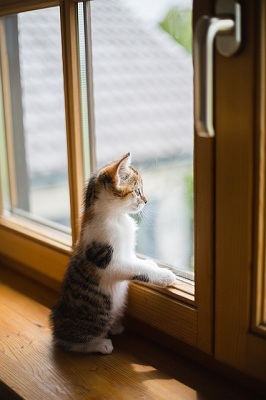How to Protect Cats from High-Rise Syndrome?
How to Protect Cats from High-Rise Syndrome?
During summer months, it becomes almost impossible to keep windows closed. It is no wonder that high-rise syndrome in cats gets almost epidemic proportions among indoor cats during the summer. Fortunately, only cats that live in the buildings are at risk. According to veterinarians, the most dangerous falls are from the second to the seventh floor. When falling from the first floor, they usually land on their feet. Interestingly, cats who fall from higher places than 7th floor usually have a better prognosis for recovery. Feline experts explain this phenomenon with cat specific anatomy. Namely, they believe cats have enough time to turn around and land on their feet when falling from higher places. Even though they rarely end up without any injury, they often have less broken bones and less inner injuries. However, to protect a cat from high-rise syndrome during the summer, feline experts recommend taking some preventive measures. They also warn us about the several most common misconceptions about cats. Many cat owners think that cats are independent and can take care of themselves. Even though cats are good at survival and will not jump willingly from a dangerous height, it does not mean that they will not jump at all. They are cautious and instinctive, but they will hardly resist jumping after a bird, fly, or some other flying body that allures them. To find out more about how to protect a cat from the high-rise syndrome, the article “High-Rise Cats” gives us the following suggestions.
How to Protect Cats from High-Rise Syndrome?
Ways to minimise the risk of falls:
– Move any furniture that would allow cats to have access to higher-level open windows.
– Make open windows safe with limiters that allow the window to only open a certain amount (designed
to keep children safe) – but remember cats, and particularly kittens, can squeeze through very
small spaces or get stuck trying.– Use meshes or barriers to cover open windows (eg, Cataire). These allow the window to fully open
and remain safe.– A balcony can provide valuable extra space and stimulation for an indoor cat but must be totally
cat proof as well. Use balcony safety nets and meshes and remember the small gaps that cats can
squeeze through.
If our protective measures fail to protect a cat from the high-rise syndrome, veterinarians advise us to take a cat immediately to a professional. According to them, 90 percent of cats survive after falling from high places. But, the statistics are true for cats that get immediate help from experts. The same is also true for cats who fall from 1st or the 2nd floor. They can be in pain, even though we do not see any external sign of injury.










